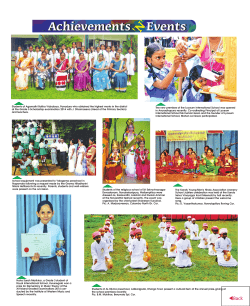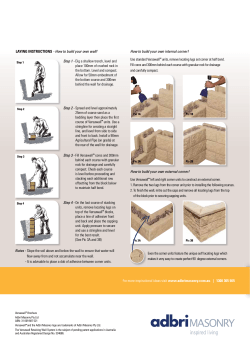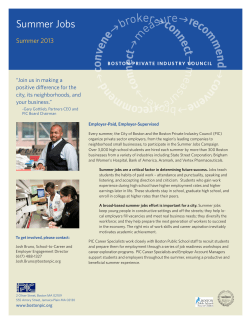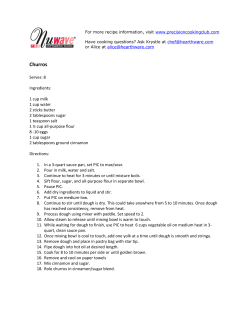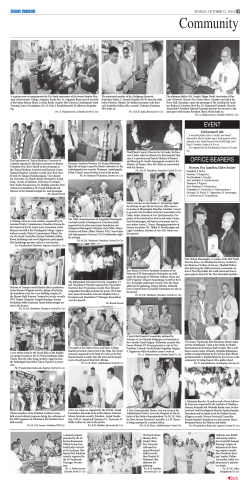
www.picscheme.org ... Leading the international development, implementation and maintenance
www.picscheme.org November 2014 Leading the international development, implementation and maintenance of harmonised GMP standards and quality systems of inspectorates in the field of medicinal products Press release: PIC/S convenes in Paris, France From 20 to 24 October 2014, the following meetings and conferences took place in Paris, France, at the “Cercle National des Armées”: PIC/S Committee, PIC/S Executive Bureau, PIC/S Sub-Committee on Training and PIC/S Annual Seminar. PIC/S INSPECTORS’ ACADEMY (PIA) IS OFFICIALLY ESTABLISHED The PIC/S Committee met on 20-21 October 2014 under the chairpersonship of Dr Joey Gouws (South Africa’s Medicines Control Council / MCC). At the meeting, the PIC/S Committee decided to establish the PIC/S Inspectors Academy (PIA). Dr Joey Gouws PIC/S Chairperson PIA is a PIC/S initiative to set up a web-based educational centre under the PIC/S umbrella which aims at harmonising and standardising GMP training at an international level through an accredited qualification system. PIC/S Committee Meeting, Paris, France PIA will not only deliver general or advanced training but also serve as a platform for discussion and sharing among regulators thus contributing to global harmonisation and interpretation of GMP. PIA will be implemented in various stages and become operational in the third quarter of 2015. The initiative already benefits from a strong support from Head of Agencies, PIC/S Members (and non-Members) as well as interested Partner Organisations and Third Parties. The idea of the PIA was announced during the PIC/S 40th Anniversary in 2011. The concept was originally mooted by Mr Boon Meow Hoe (HSA / Singapore), that PIC/S creates a professional “Inspectors’ Academy” delivering a variety of courses ranging from general training to highly specialised training for inspectors. Interview of Mr Boon Meow Hoe (Singapore / HSA), Chairman of the PIC/S Sub-Committee on Training and the PIA Ad-Hoc Working Group Q: You are generally considered as one of the “spiritual fathers” of PIA. How did this idea come about? Mr Boon Meow Hoe A: One of the key roles and functions that PIC/S provides is training. It is a great challenge and an uphill task to harmonise GMP inspections among different National Drug Regulatory Authorities (NDRA) across the world. An “education centre” is a pragmatic approach to “calibrate” GMP inspectors and to uphold consistency in the interpretation of GMP, the classification of GMP deficiencies, © PIC/S NOVEMBER 2014 inspection methodology, inspection skills and inspectors’ qualification. My sense is that to achieve PIC/S’ mission, which is “to lead the international development, implementation and maintenance of harmonised Good Manufacturing Practice (GMP) standards and quality systems of inspectorates in the field of medicinal products”, there is a need to formalise all PIC/S training activities. Changes today are taking place at an internet speed against the backdrop of globalisation. Most NDRAs have a greater workload but simultaneously less financial and human resources. The training activities of PIC/S need to transform and embrace information technology to make training more easily accessible. cont’d 1/4 www.picscheme.org In addition, considering that PIC/S encompasses all continents, perhaps the need of “decentralized” regional trainings is necessary. As part of my obligation of representing HSA/ Singapore in PIC/S, I regularly update and discuss PIC/S matters with my colleagues in my agency and from these discussions the concept of the Inspectors’ Academy was born. The concept is not a novelty: police inspectors have their Academy and so does a fast food operator which has its own “Hamburger University”, so why not GMP inspectors! Inspectors should learn about changes in pharmaceutical technology from the indus- November 2014 try; however, inspectors should be trained on “how to inspect” by inspectors. Hence, the need to train the inspectors, the need to “calibrate” inspectors globally, the need to “converge” with a view to harmonise GMP Inspectorates. This is how PIA, a global PIC/S training initiative, was mooted. Q: What will be the greatest challenges of PIA? A: The greatest challenges of PIA in its initial phase will be people, time and funding. Subsequently, in an operational phase, the key challenge of PIA will be how to be sustainable. Seminar on Dedicated Facilities A PIC/S Seminar was organised by the French National Agency for Medicines and Health Products Safety (Agence nationale de sécurité du médicament et des produits de santé – ANSM) in Paris, France, on 22-24 October 2014. The topic of the seminar was the management of “dedicated facilities”. For years, this subject has been a strategic issue for both industry and regulators. In particular, the risk management of potential cross-contamination when toxicologically sensitive products are manufactured such as highly sensitising materials (i.e. penicillin), sexual hormones, cytotoxics, highly active or potent products, ectoparasiticides or vaccines. The impact of “dedicated facilities” is very significant with regards to public health and decisions made by industry in designing and operating manufacturing sites. The Seminar, which is the second one in the recent history of PIC/S organised in France, was attended by 156 participants from 56 countries. All continents were represented. The Seminar’s objectives were to discuss about design, implementation and management of dedicated facilities as well as inspection strategies. The harmonisation of approaches on this topic is a critical point for both inspectors and industry. PIC/S Seminar 2014, at Cercle National des Armées Paris, France The 2.5 day Seminar started with a series of lectures and presentations, followed by four parallel workshops on the 2nd day of the Seminar. © PIC/S NOVEMBER 2014 2/4 www.picscheme.org November 2014 The workshops dealt with: • The impact of personnel movement between dedicated and non-dedicated facilities (Workshop Leader: Canada / HPFBI); • Dedicated and non-dedicated facilities applied to veterinary medicinal products (Workshop Leaders: France / ANSES and UK / VMD); • The identification of cross-contamination and/ or risk analysis using the ISPE risk-map (Workshop Leader: Poland / MPI); • The impact of the airborne transfer of non-viable particles when introducing a new active substance in a non-dedicated workshop (Workshop Leader: France / ANSM). During the last day of the Seminar, a summary of the outcome of the workshops was presented followed by a discussion on the follow-up to be given to the Seminar. Inspectors agreed to establish a PIC/S Expert Circle on Dedicated Facilities, which will have the task to draft an Aide Memoire on the inspection of dedicated facilities, as well as to provide training to inspectors on this difficult issue. The Aide Memoire will focus on harmonising terminology used in relation with dedicated facilities as well as propose definitions, which are internationally acceptable. Questions that inspectors should ask themselves during inspections should also be listed – in particular in relation with the risk management of companies on dedicated facilities. According to a PIC/S survey, 60% of all inspectors have not received any training in this critical field: as a result, the Expert Circle will work on a training programme for inspectors. The Expert Circle will start as a Working Group in charge of elaborating a mandate for the future Expert Circle. The following PIC/S Participating Authorities have committed to provide the necessary support to the PIC/S Expert Circle (in alphabetical order): Argentina / INAME, France / ANSM, Ireland / HPRA, Italy / AIFA, Poland / MPI, South Africa / MCC, UK / MHRA, and US FDA. Some Partner Organisations such as WHO will also be associated in the work of the Expert Circle. Interview of Mr Jacques Morénas (France /ANSM), Chairman of the PIC/S SubCommittee on Strategic Development and Member of the Organising Committee of the 2014 Seminar on “Dedicated Facilities” Mr Jacques Morénas Q: The PIC/S Deputy Chairman, Mr Paul Hargreaves (UK / MHRA), considers the French to be very brave to organise a seminar on “dedicated facilities” because it is a challenging topic. Are you satisfied with the outcome of the 2014 Seminar? A: As a matter of fact, ANSM has been well aware of the challenge… For many years, regulators have talked about this topic but without going into details. It was high time to discuss the issue in-depth. I am very satisfied with the outcome of the seminar. I really hope that PIC/S will issue an Aide Memoire facilitating life for both regulators and industry. © PIC/S NOVEMBER 2014 Q: Is there a risk that companies concentrate manufacturing requiring dedicated facilities in countries where the regulation is less stringent? A: The prime responsibility for ensuring the adequate quality of medicinal products (as defined in the marketing authorisation) remains in the hands of pharmaceutical companies. They are liable for quality defects and their consequences on the health of patients. For this reason, I am confident that industry will not take such a risk without appropriate management. Q: France / ANSM has been traditionally very active in PIC/S. For what reasons? A: France has been part of the PIC/S family since 1992. From the beginning, we have understood that the world (including the 3/4 www.picscheme.org pharmaceutical one) is more and more globalised and that a single agency cannot manage alone the risks related to medicinal products and API. A harmonised approach between regulators on regulations and training is critical to face globalisation. Q: The PIC/S Sub-Committee on Strategic Development currently discusses the issue November 2014 of whether to involve PIC/S in the management of “drug shortage”. What could be the outcome of this discussion? A: A possible conclusion could be that GMP inspectors should be involved in the thinktank on drug shortages, as the outcome of their inspections can have an impact in this field. In Short • Japan’s MHLW & PMDA and Korea • • • • • • • / MFDS attend the Paris PIC/S Committee meeting as full Members for 1st time after accession to PIC/S on 1 July 2014; Croatia / HALMED applies for membership on 5 September 2014; Brazil / ANVISA completes membership application; PIC/S on-site assessment visits will be scheduled in 2015 in Hong Kong, Panel of speakers, joint EMA and PIC/S training of auditors, October 2014, EMA HQ, London (UK) Iran and Turkey; The pre-accession gap analysis has been completed for Armenia, Mexico & Uganda; The PIC/S Committee agrees on joint drafting group with EMA IWG on GMDP on the revision of Annex 1 (sterile manufacturing) of the PIC/S-EU GMP Guide; Ireland / HPRA organised for PIC/S a “New Inspector Training Course” and a “Train the Trainer Course” on 16-20 June 2014 in Dublin (Ireland); A joint EMA and PIC/S training of auditors for the EU Joint Audit Programme (JAP) and the PIC/S Assessment and Joint Reassessment Programme (JRP) has been organised in London (UK) on 27-28 October 2014. Coming up… 8-10 December 2014: PIC/S Advanced QRM Training Courses in Tokyo (Japan) organised by Japan / PMDA; 22-23 January 2015: PIC/S-PDA ICH Q7 Training in Seoul (Republic of Korea) jointly organised with PDA and Korea / MFDS, with the support of the EU Commission; 10-12 February 2015: PIC/S-PDA ICH Q7 Training in Brasilia (Brazil) jointly organised with PDA and Brazil / ANVISA, with the support of the EU Commission; © PIC/S NOVEMBER 2014 24-26 March 2015: PIC/S Expert Circle on GDP in Taipei hosted by the Taiwan Food and Drug Administration (TFDA); 7-9 October 2015: Annual PIC/S Seminar hosted by NADFC in Nusa Dua (Indonesia); 20-22 October 2015: PIC/S Expert Circle on APIs in Strasbourg (France), hosted by EDQM; 26-30 October 2015: PIC/S Expert Circle on Human Blood, Tissues & Cells focusing on ATMP in Rome (Italy), hosted by AIFA. 4/4
© Copyright 2026
